 |
 |
 |
| |
Ezetimibe Reduces LDL-C for HIV+ on HAART
|
| |
| |
"Ezetimibe's Effects on the LDL Cholesterol (LDL-C) Levels of HIV-Infected Patients Receiving Highly Active Antiretroviral Therapy (HAART)"
Reported by Jules Levin
CROI, Feb 26, 2007, Los Angeles
David Wohl from the University of North Carolina and the ACTG reported this study at the Monday morning oral session on Metabolics.
.... A 1% drop in LDL corresponds to a 1% drop in CVD risk. So a 10% or so decline in LDL is nothing to dismiss, especially in patients who can not or will not take a statin.....
Wohl concluded:
"In HAART treated patients six weeks of ezetimibe alone reduced LDL-C by 12% (95% CI: 2%, 22%) compared to placebo. There was no significant effect of ezetimibe on HDL-C or triglycerides compared to placebo. Therapy was well tolerated with no serious adverse effects observed on therapy. This trial, the first placebo-controlled study of ezetimibe in HIV+ patients receiving HAART, suggests a role for ezetimibe in the management of elevated LDL-C in patients with HIV. For HIV+ patients with elevated LDL-C who are unable to take a statin, monotherapy with ezetimibe may be an option".
Background
Ezetimibe is a selective inhibitor of cholesterol absorption that reduces cholesterol absorption in the duodenum by approximately 50%.
Metabolism of ezetimibe is via glucoronidation, independent of the cytochrome CYP 3A4 pathway.
In clinical studies of HIV-uninfected individuals, ezetimibe has been demonstrated to reduce low density lipoprotein (LDL)-cholesterol by ∼20% when used alone and up to ∼50% when co-administered with a statin.
Two pilot studies of ezetimibe in HIV-infected patients have been published.
- Negredo et al (2006) - Single arm study of addition of ezetimibe
to statin in 19 HAART treated patients with LDL-C >130mg/dL. ∼15% reduction in LDL-C by 24 weeks.
- Coll et al (2006) - RCT of 20 patients on HAART with LDL-C
>130/mg/dL not on statin assigned ezetimibe versus fluvastatin. 20% reduction in LDL-C with ezetimibe at 6 weeks.
PRIMARY STUDY AIM
--To determine the effect of ezetimibe on LDL-C levels in HAART-treated HIV-infected patients
--And to explore the safety and tolerability of ezetimibe in HAART-treated HIV-infected patients
--the secondary aim is to determine the effect of ezetimibe on HDL-C and fasting triglycerides
STUDY POPULATION
- Documented HIV +
- 18 - 65 years of age
- Stable triple-drug antiretroviral regimen for ≥3 months with no plans to change regimen during the 14 week study
- LDL-cholesterol > 75 mg/dL within 21 days of entry
- Fasting triglycerides < 800 mg/dL within 21 days of entry.
- Not receiving a lipid-lowering medication within 3 months of entry including statins, fibrates, niacin, fish oil
- CD4+ count > 100 cells/mm3 within 21 days of entry
- HIV viral load < 10,000 copies /mL within 60 days of entry
- Not pregnant/breastfeeding
- ALT or AST levels < 1.5 times ULN within 21 days of entry
Serum creatinine < 1.5 times ULN within 21 days of entry
STUDY DESIGN
Patients were randomized to ezetimibe 10 mg daily (n=25) or placebo (n=23) for 6 weeks, 2 weeks washout, then placebo patients received drug and exetimibe patients received placebo.
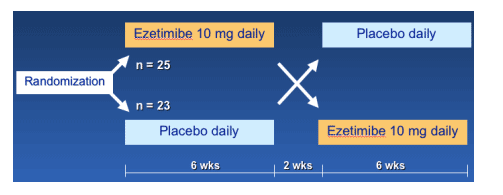
METHODS
Randomized, double-blind, placebo-controlled, two-period cross-over trial.
Differences in percent change of LDL-C (%delta LDL-C) from pre- to post-intervention between ezetimibe and placebo were compared using generalized linear models with a normal probability distribution fit with generalized estimation equations to account for repeated measures.
All analyses ITT - LOCF.
RESULTS
Patient Characteristics
Median LDL was 121; CD4 555; 98% <400 c/ml; 100% on ART, 58% PI. 77% male; 48% black, non-hispanic; age: 46 yrs.
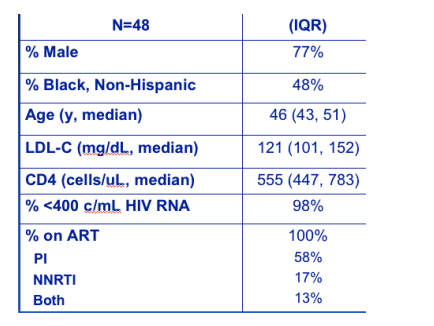
PRIMARY OUTCOME
Median reduction in LDL-C was 12% for patients receiving ezetimibe amd for placebo recipients median LDL-C increased 3%.
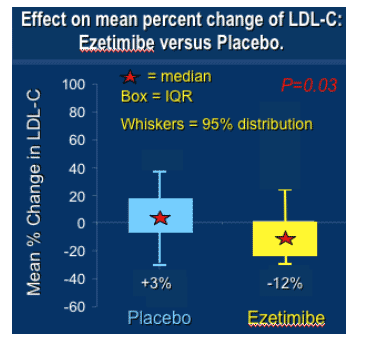
Mean LDL-C was about 128 at week 0 and 116 at week 6 for exetimibe recipients. For placebo recipients mean at week 0 was about 128 and 132 at week 6 (p<0.05).
- Difference in %delta LDL-C ezetimibe vs placebo: -12% (95% CI: -22%, -2%), P=0.02 (GEE)
- 35% of patients had at least a 17% drop in LDL-C after 6 weeks of ezetimibe.
- Treatment period did not affect the results (P=0.85)
- 3 changed ART: 2 while on placebo, 1 NRTI change, 1 APV/r to FPV/r, 1 ATV/r to ATV
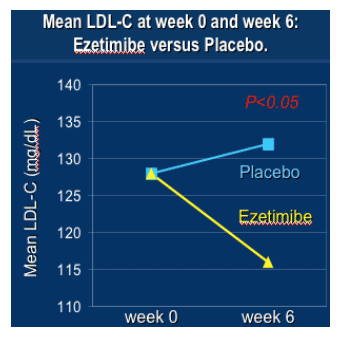
SECONDARY OUTCOMES
Triglycerides: for placebo, 159 mg/dL at week 0 & 165 at week 6; for ezetimibe, 164 at week 0, 148 at week 6.
HDL-C: for placebo, 46 mg/dL at week 0, 43 at week 6; for ezetimibe: 44 at week 0, 46 at week 6. None of these were statistically significant.
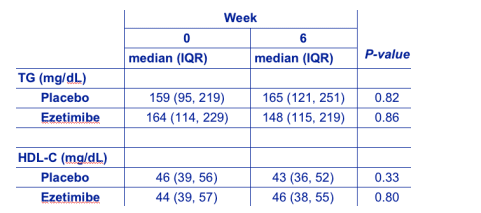
TOLERABILITY
There was no change in CD4+ cell count during study treatment.
5 participants prematurely discontinued study drug:
3 during Placebo
-- (1-grade 2 ALT, 1-HA/nausea, 1-neuropathy).
2 during Ezetimibe
-- (1-grade 3 ALT in subject with grade 1 ALT at entry, 1-epigastric pain)
Other new adverse events (>Grade 2):
5 additional patients had adverse events
-- 2 headache (1 Ezetimibe, 1 Placebo)
-- 1 diarrhea (Ezetimibe)
-- 1 central chest pain and SOB (Ezetimibe)
-- All of these patients completed the study on drug.
|
| |
|
 |
 |
|
|